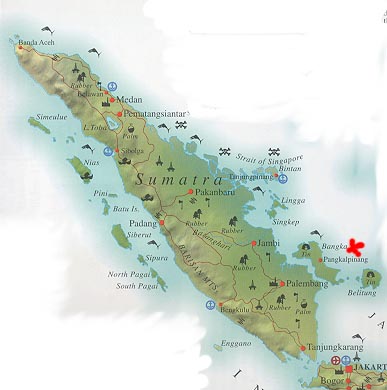 | Written and Researched by Margaret Odrowaz-Sypniewska, Bachelor of Fine Arts
 |
Singapore is approximately 224 square miles (217 of them on the main island). Three quarters of Singapore's population is Chinese.
Until World War II, it was the seat of the greatest British naval base in Asia. Two rivers run through the city: the Singapore and the Rochore. In the Malay section of Singapore, houses are built on stilts much like in Shanghai. Singapore's prosperity is built on trade and industry. The climate is hot and damp, with little change from season to season.
 | Malay Peninsula: The peninsula is about 700 miles long and 50 to 200 miles wide. On the northern half of the peninsula is Thailand (Siam). The southern half is the Federation of Malaysia. In 1957, Malaya became independant. In 1963, Singapore and two sections of Borneo, North Borneo, and Sarawak, joined Malaya to create Malaysia. Locations of the three Malay branches of Malcolm & Co., Ltd. are underlined in red. Singapore, an island off the southern end of the Malay Peninsula was considered "The Gibraltar of the Far East." The fall of Singapore, to the Japanese, was considered one of Great Britain's worst defeats in World War II. |
In 1824, the entire island came under British control. Singapore was occupied by the Japanese during World War II, but it was returned to the British and became a separate Crown colony in 1946, By 1958, Singapore was self-governing, before it joined Malaysia. Finally, in 1965, it was an independent republic.
British interests in Singapore and Malaya, were part of the East India Company. In 1818, Sir Stamford Raffles, an East India employee and governor of Java, identified Singapore Island as an excellent location for a free port.
By 1867, Singapore was an English Crown Colony.
There has been much written about the fall of Singapore. Singapore Island, Penang Island (Georgetown is a town there), and Kuala Lumpar (the capital of Malay), were all located on, or offshore from, the Malay Peninsula. These locations had branches of the main office of Malcolm & Co. Ltd. on Wayfoong Road in Shanghai, China (locations in 1933). Singapore was a great fortress, but it left 1,000 miles of the Malayan coast unprotected.
Alexander Malcolm, my great-uncle, fled from Shanghai before the Japanese occupation there from 1937-1945 (the exact date is not known).
January 17, 1941 - In Johor Bahara (Jahore straits), the allied forces try to stop the Japanese, from making their overland attack, by bombing the bridge from there to Singapore. Many British engineers are asked to plot out the way to this end. It could be possible (there is no proof) that Alexander Malcolm might have advised them on where to lay the explosives. These same engineers are well versed in the most pausible stress points of the structure. Many Japanese were killed on the bridge as it is blown up. That was only a temporary aid.
General Tomoyuki Yamashita's 25th Army landed at Singora, Pattani, and Kota Bharu, near the border between Malaya and Thailand (called Siam until 1939). Japanese troops move south causing the British to withdraw to Singapore. The island falls 70 days after, as Yamashita had predicted.
British warships pull out of Singapore harbor on December 8, 1941, escorted by four destroyers. However, Japanese "zero" fighters destroy the British warships the Prince of Wales and the Repulse, as they leave the port of Singapore to defend the Malaya Peninsula. Four of the six British ships were destroyers. The British thought they would be attacked by sea, but that was a fatal mistake since the Japanese surprised them from the north, by land.
| The Repulse was a 32,000 ton battle cruiser. It was sunk at 12:33 p.m. on December 10, 1941. The 35,000 ton Prince of Wales was sunk at 1:15 a.m. on December 11, 1941, by Japanese torpedo planes. |
December 11-12, 1941 - In Jitra (in Kedah) the British are defeated by the Japanese. The Japanese excel in jungle tactics. When the British retreat, the Japanese find some maps, which they put to good use in their journey southward.
December 15-16, 1941, the Japanese bombed Penang and killed many people.
January 11, 1942 - in the railway yards, of Kuala Lumpar, the Japanese discover food and ammunitions, and find military maps of Singapore.
February 15, 1942 - Singapore surrenders, when food, water, ammunition, and gasoline are nearly gone. They were taken to the Ford Motor Company assembly plant on the outskirts of Singapore town. Here Lt. General A. E. Percival yielded to Lt. General Tomoyuki Yamashita's 25th Army.
820 British seaman were lost, while 2,081 were picked up by flotilla destroyers. Of the 88 Japanese planes, only four were shot down.
It is thought that the Naval Base was evacuated, just before the fall of Singapore on February 15, 1942. The Aquarius sailed on February 12/13, 1942 and sunk off the Sumatra coast north of Banka Island by air attack. Three survivors were picked up, but they also died shortly after. Unfortunately, the Aquarius never made its Darwin, Australia, destination. The Aquarius was launched on February 14, 1934, as the R.A.F.A. (Royal Air Force Auxilliary) "Aquarius," and was an aircraft tender. It arrived originally in Singapore on May 28, 1934. There are many accounts of the Aquarius in various sources, and some accounts are about two U.S.A. ships also named Aquarius. There was a listing for an Aquarius as a U.S. Navy attack cargo ship (AKA 16) of the C2 type commissioned in 1943. However this ship is thought to have been 6094 tons and did not sink. It ended up in the Soviet Union in 1945. One account has the passengers of the ship at 1,000 and while the British vessel carried 60-70 persons. In both cases, it is stated that there were three survivors picked up, who then died shortly thereafter. One account says they were picked up by ML 310s. The same account has the the ship being sunk by a Japanese destroyer near Tjebia Island (off Sumatra) on February 15, 1942.
I originally thought that the Aquarius was the ship that my uncle died on when it sunk. Now I know that Alexander Malcolm died after the sinking of the SS Redang.. The SS Redang was registered in Bangkok, Thailand, to the Siam Steam Navigation Fleet, and was seized by the British government, and was then made part of the Singapore Strait Steamship Company. On February 12, 1942, this ship was attacked by two Japanese destroyers and sunk. Alexander Malcolm and his friend, Tommy Hand, died 50 miles from the Berhala Strait one of many casualties of World War II.
|
NEW INFORMATION: Current evidence regarding the shinking of the SS Redang can be found here: Commonwealth War Graves Commission.
|
Sumatra:

Sumatra is the second-largest Indonesian island. Sumatra's area is approximately 163,145 sq. miles (about the size of California, U.S.A.). Much of Sumatra is mountainous with thick forests. The people of Sumatra include Malays, Chinese, Arabs, and Indians. Most of the people are Mohammedan faith (Islamic).
The Dutch controlled Sumatra as part of the Netherlands East Indiea until World War II. In 1945, most of the island was included in the first Republic of Indonesia.
Many of the Europeans, of Malay, were placed in POW camps from 1942-1945. They were used as a work force to clean up the city, bury the dead, and to restore water and electricity. They also constructed a railway in Thailand, an with little to eat, many died of starvation. Those who lived were quite literally "skin and bone."
Sources:
Marine History Information Exchange Group. A special thanks to Keith E. Allen of Canada, David Asprey of the United Kingdom, Ian L. Buxton of the U.K., Brian Hargreaves of the U.K., Richard Pelvin of Australia, and Mike Yared, for helping me sort out the information about the various ships called Aquarius.
Sulzberger, C. L. The American Heritage Picture History of World War II. New York: American Heritage Publishing Company, Inc., 1966.
Time-Life editors. WWII: History of the Second World War. New York: Prentice-Hall Press, 1989.
RELATED LINKS:
Shanghai, China ... Alexander Malcolm
Civilian Internees of the Japanese in Singapore During WWII...The British in Singapore and Malaya
The Fall of Singapore: Blame Churchill ...The Fall of Malaya and Singapore
Scottish Table of Contents
Owner: Raymond Sypniewski, B.S., M.A.
Email Margaret: Margaret
This page was last updated on November 27, 2005
